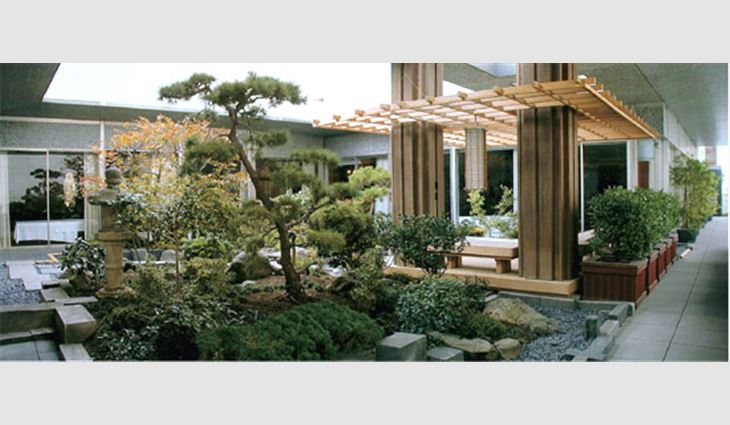 Photo courtesy of Western Roofing Service.
Photo courtesy of Western Roofing Service.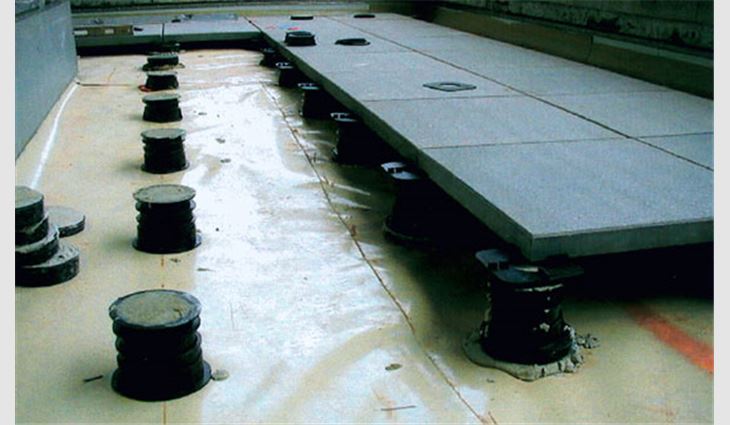 Photo courtesy of Western Roofing Service.
Photo courtesy of Western Roofing Service.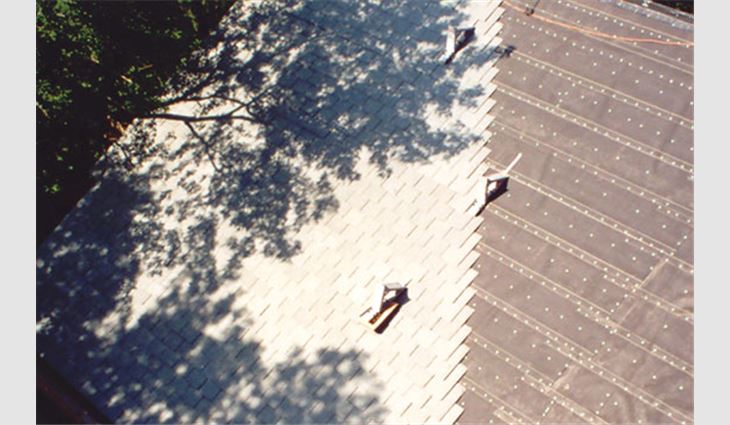 Photo courtesy of F.J.A. Christiansen Roofing Co. Inc., Milwaukee.
Photo courtesy of F.J.A. Christiansen Roofing Co. Inc., Milwaukee.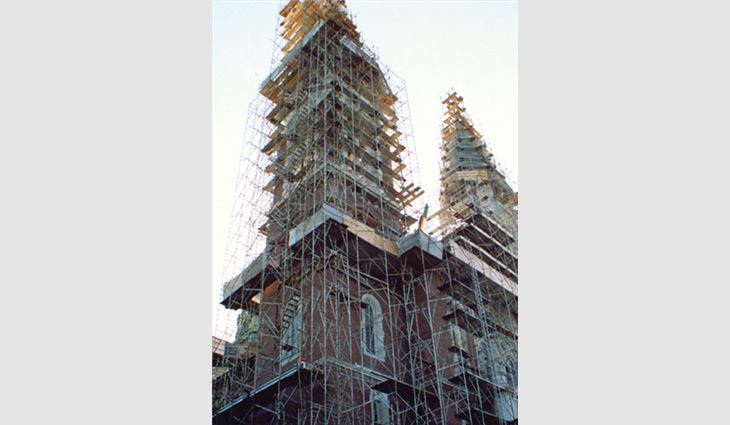 Photo courtesy of F.J.A. Christiansen Roofing Co. Inc., Milwaukee.
Photo courtesy of F.J.A. Christiansen Roofing Co. Inc., Milwaukee. 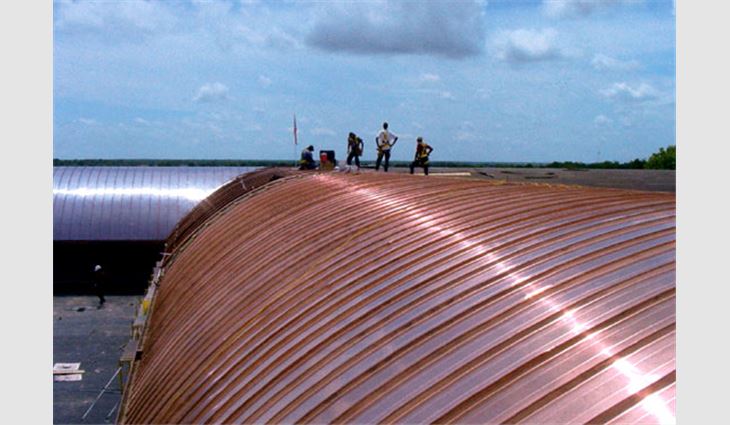 Photo courtesy of Edward J. Laperouse Metal Works Inc., Houma.
Photo courtesy of Edward J. Laperouse Metal Works Inc., Houma.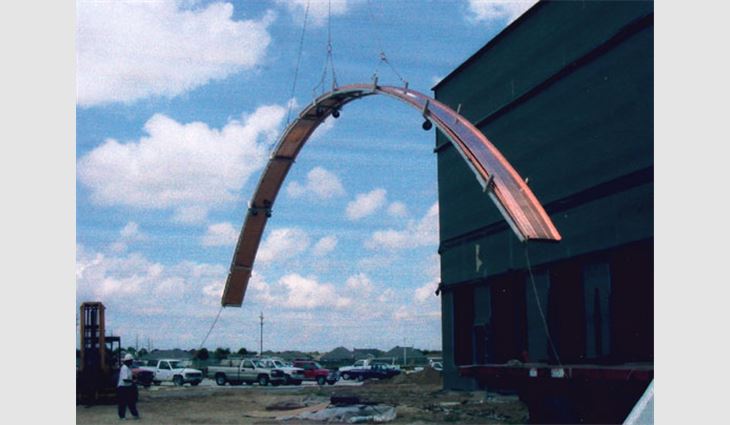 Photo courtesy of Edward J. Laperouse Metal Works Inc., Houma.
Photo courtesy of Edward J. Laperouse Metal Works Inc., Houma. 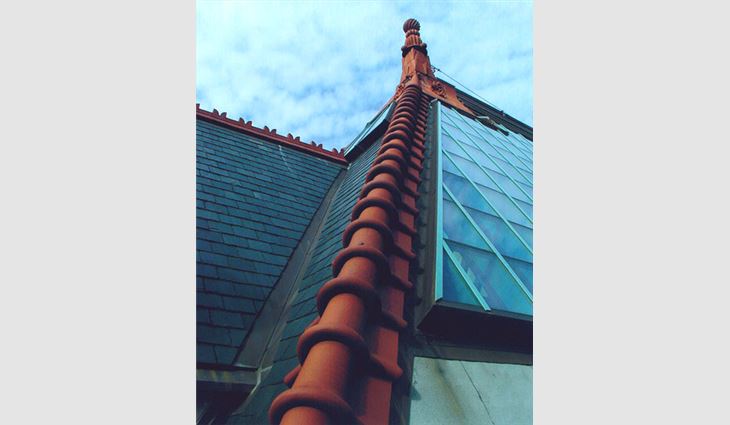 Photo courtesy of Titan Roofing.
Photo courtesy of Titan Roofing.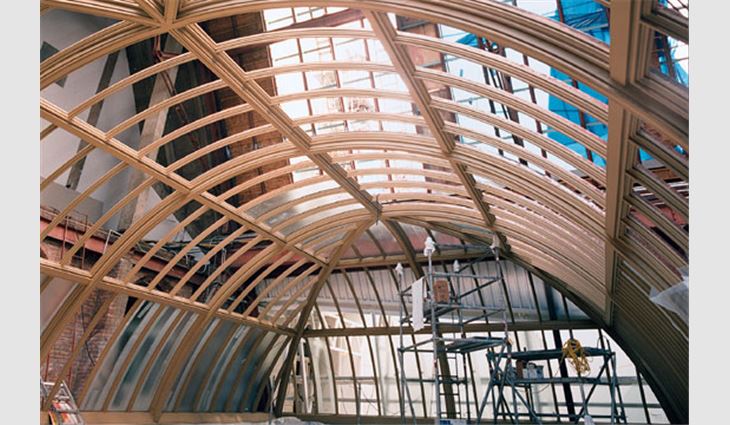 Photo courtesy of Titan Roofing.
Photo courtesy of Titan Roofing. Receiving recognition often validates the efforts one exerts to accomplish a task. NRCA created its Gold Circle Awards in 1995 to recognize its contractor members who significantly contribute to the roofing industry by creating innovative solutions, having outstanding workmanship, and providing service to the community or industry. The awards are bestowed during NRCA's annual convention, and Professional Roofing commends the award winners and highlights the winning projects in those categories.
This year, NRCA also presented its first Excellence in Design Award. To qualify, entries had to demonstrate the design of long-lasting, energy-efficient, environmentally friendly roof systems according to accepted industry practices. Five finalists were selected. Click here to learn more about the projects.
Gold Circle Award category: Outstanding workmanship—low slope
Recipient: Western Roofing Service, San Francisco
Project: Wells Fargo Bank headquarters, San Francisco
Roof system types: Torch-applied modified bitumen and thermoplastic loose-laid membrane
The Wells Fargo Bank headquarters is in San Francisco's downtown financial district. The building is distinctive because of a rooftop Japanese garden that sits at the penthouse level.
The garden, which was built about 40 years ago, is above the bank's executive offices and visible from the boardroom and dining facilities.
But the rooftop garden posed some problems—the building's maintenance staff had addressed roof system leaks for several years. To stop leaks, the coal-tar membrane roof system under the garden and another coal-tar membrane roof system at the penthouse level needed to be replaced. Western Roofing Service was selected as the roofing contracting company to complete this project.
Details
The roof system replacement work began in fall 2000. Bank authorities stipulated the garden was to remain intact and bank employees were not to be disturbed by the roofing work. To add pressure to those involved with the project, the bank's retiring chief executive officer wanted the roof system replacement to be completed by his retirement in spring 2001.
"To design and implement a solution to achieve these goals within the necessary time frame would require that design consultants, contractors and subcontractors work together with utmost professionalism and discretion," says George O'Neill, senior vice president of Western Roofing Service.
Before tear-off work began, the garden was surveyed and documented with a grid system. To ensure every plant, stone, sculpture and rock was returned to their precise locations, items were numbered and tagged according to the grid before being removed.
A majority of the tear-off and replacement work was done after bank hours—from 10 p.m. to 6 a.m.—because the work would have been disruptive to bank employees. For example, some tear-off materials and garden items were taken out of the building through public corridors. This work was done in the evening so bank employees were not disturbed.
Improvements
Once the tear-off was completed, a torch-applied modified bitumen roof system—Siplast Paradiene 20/30—was installed on the area without the garden. The garden area received a Sarnafil thermoplastic loose-laid membrane roof system. During replacement work, achieving proper roof slope was important to help with drainage.
O'Neill explains: "The roof deck virtually was flat with little slope and few drains. Four drains were added, and the area under the garden was re-sloped to these drains and existing drains."
In addition to roof system improvements, the garden also was updated. The original large aggregate concrete pavers were enhanced with granite pavers, and a dry-rot cedar platform in the garden was rebuilt to replicate the original design. Only one plant was damaged during the roofing work; other plants and trees were added to improve the garden's aesthetics.
O'Neill adds: "With few exceptions, the bank had little disruption of its executive operations. The building's maintenance staff benefits from a leak-free roof system with the flexibility to reach and perform new repairs should the need arise. The concrete patio and walkway were replaced with pedestals and pavers that easily can be removed to make repairs and reinstalled without damage. And the original design lives on for future generations to enjoy with a rehabilitation that preserves and enhances the original concept."
Gold Circle Award category: Outstanding workmanship—steep slope
Recipient: F.J.A. Christiansen Roofing Co. Inc., Milwaukee
Project: Hubertus, Wis.-based Holy Hill—National Shrine of Mary, Help of Christians
Roof system types: Slate, copper and APP-modified bitumen
In May 2002, F.J.A. Christiansen Roofing began its job at Holy Hill—National Shrine of Mary, Help of Christians. The roofing contracting company was named the project's prime contractor and asked to restore the exterior of the Neo-Romanesque church that was dedicated in 1931.
Holy Hill, which rises 1,335 feet (407 m) above sea level, sits on the highest peak of Kettle Moraine, a chain of hills and valleys in Wisconsin. The Discalced Carmelite Friars, a Roman Catholic community, runs the church.
Roof system leaks, masonry problems and other exterior damages had caused extensive water damage to the church's interior (interior renovations began after the exterior project was finished). F.J.A. Christiansen Roofing performed extensive amounts of work on the church, but several subcontractors helped repair exterior damages.
Subcontractors
Secure, safe scaffolding was essential to this job because the scaffolding was used by all trades. Patent Construction Systems, Paramus, N.J., erected scaffolding around the 190-foot- (58-m-) tall church and two bell towers on April 30, 2002.
The scaffolding was meticulously constructed—high winds common at Holy Hill could have ripped the scaffolding apart, injuring workers. Therefore, Patent Construction Systems tied every second frame in length and height instead of every third frame, which typically is done for scaffolding. And planks and plywood were more rigorously secured.
Another subcontractor that contributed to the project was NRCA member Vande Hey Roofing Tile Co. Inc., Little Chute, Wis., which tore off the building's 80-year-old, asbestos-containing slate roof system and installed a new slate roof system.
F.J.A. Christiansen Roofing topped off Vande Hey Roofing Tile's work by installing new copper flashings, valleys, downspouts, in-laid gutters and decorative ridge caps, as well as crosses.
Prime contractor
Sheet-metal work performed by F.J.A. Christiansen Roofing was central to the project. But the company performed several other tasks. One task was to reroof the inside of the church's center spire, which is 30 feet (9 m) below the church's observation level, as well as repair copper on the spire. Getting to the roof area inside the spire to perform reroofing work made the project an adventure.
Two F.J.A. Christiansen Roofing workers climbed the south tower (about five flights of stairs) with materials and exited through a small door that opens to the ceiling of the main church. The workers then walked across a wooden catwalk that leads over the arched ceiling of the main church to the 20- by 20-foot (6- by 6-m) roof area in the spire.
The reroofing work included priming an existing smooth-surfaced built-up roof (BUR) system. Then, Derbibase,® an APP-modified bitumen base sheet, was laid in Permastic® adhesive. Next, cold-applied Derbicolor® XPS FR was installed in Permastic adhesive. These products are manufactured by Performance Roof Systems Inc., Kansas City, Mo. F.J.A. Christiansen Roofing installed Performance Roof System's Derbigum® products on several other low-slope roof areas, as well.
Another area F.J.A. Christiansen Roofing workers reroofed was a connecting link that joins the monastery to the church. Roofing workers tore off the connecting link's BUR system and installed a flat-seam copper roof system.
All copper was fabricated at the company shop. Three sheet-metal workers were on-site to cut, bend and install copper. In all, F.J.A. Christiansen Roofing had about 10 roofing workers to 15 roofing workers on-site daily.
Holy land
During the project, workers showed their respect for the friars and holy land at Holy Hill.
Rob McNamara, president of F.J.A. Christiansen Roofing, explains: "Each weekday at 10:45 a.m., the church bells would ring to signal to all craftsmen on-site that the 11 a.m. mass was about to begin. At this time, all workers on the project would discontinue their work and take their lunch break from 11-11:45 a.m. Occasionally, a funeral service would be held, and we had to keep church doorways available for ingress and egress. Saturday weddings typically were not an issue because we did not have construction activity taking place on those days. But pedestrian protection/walkways were [sustained] throughout the project. The only other matter was clear communication with all working on the project that respectful behavior was required at all times in recognition of this special place of worship."
F.J.A. Christiansen Roofing's planning and coordination with the subcontractors and friars paid off—work was finished on time with no injuries.
"That this project was completed without any safety incidents is a testament to the high level of professionalism and respect given to this unique historic, sacred landmark," McNamara adds.
But workers may have received a little help from the powers that be.
"The workmanship here was absolutely magnificent," says Father Cyril Guise, shrine director. "The workers showed respect for the shrine as a holy place. We prayed a special prayer every day for the workers to be kept safe."
In mid-November 2003, the $3.3 million exterior renovation project was completed. The Discalced Carmelite Friars' goal is to have interior renovations completed by 2006, the 100th anniversary of the community's arrival at Holy Hill.
Gold Circle Award category: Innovative solutions—new construction
Recipient: Edward J. Laperouse Metal Works Inc., Houma, La.
Project: Terrebonne Parish Main Library, Houma
Roof system types: Standing-seam copper and SBS-modified bitumen
The Terrebonne Parish Main Library is a state-of-the-art facility that opened in spring 2003. The new library, which is part of a community facilities campus, incorporates the latest in information technology and distance-learning systems.
Edward J. Laperouse Metal Works was chosen to work on the project, which began in September 2001. The building features an SBS-modified bitumen roof system and standing-seam copper roof system. It is the copper roof system that gives the building its unique look—the copper panels are curved to cover a T-shaped barrel-vault substrate.
Roofing work
Ten sheet-metal workers formed the 20-ounce copper panels on-site using a Knudson KR-24 rollformer. The 16-inch- (406-mm-) wide panels have 1 1/2-inch- (38-mm-) high vertical standing seams. The formed panels were curved with a Schlebach RBM 25/38 arch bending machine. Those involved with the project were concerned hoisting the panels by crane alone would damage the panels' precise curves. Therefore, the panels were secured to a custom-made aluminum cradle before being hoisted.
The panels were fastened 24 inches (610 mm) on center with 20-ounce copper concealed clips and then double-locked with a Schlebach Piccolo Universal knuckle seamer.
Arched copper panels also were installed on two porte-cochere entrances, and a sidewalk entryway features a gable-shaped copper roof system. In addition, a 23,000-square-foot (2137-m²) SBS-modified bitumen roof system was installed on a section of the library. This system features a Siplast Paradiene 20/30 roof membrane over Siplast Zonolite Concrete and was installed by eight roofing workers.
The rewards
Those involved with the project suffered a loss when the project's architect, Tom Whitney of Cheramie/Whitney Architects, Houma, suddenly passed away during the project. For Jude Laperouse, president of Edward J. Laperouse Metal Works, working with Whitney was one of the most rewarding parts of the project.
After Whitney's death, Laperouse viewed the project as a tribute to Whitney's innovative design. Laperouse believes winning a Gold Circle Award not only commemorates Whitney's work but also celebrates the efforts and ingenuity of those who truly deserve the award—the roofing workers.
"I could not be more proud of our sheet-metal and roofing craftsmen who brought Tom's design to reality," Laperouse says. "Their talents and absolute commitment to excellence resulted in a showcase project of which everyone can be proud."
Laperouse adds: "The Gold Circle Award belongs to the workers. It was my honor and privilege to accept it on their behalf and in memory of my friend Tom."
Gold Circle Award category: Innovative solutions—reroofing
Recipient: Titan Roofing Inc., Chicopee, Mass.
Project: New York State Capitol, Albany
Roof system types: Clay tile, terra cotta, liquid-applied membrane, slate and copper, as well as skylight and laylight repairs and waterproofing membrane under concrete wearing slab
The most thrilling parts of a building typically are not staircases. But such is the case for the New York State Capitol, which was built from 1867-99 for $25 million. The five-story, 500-foot- (152-m-) long, 300-foot- (91-m-) wide building has three major staircases. These staircases feature breathtaking stone carvings and elaborate skylight systems.
The most admired staircase—because of its more lavish carvings—is the Great Western Staircase, which also is called the Million Dollar Staircase. Years of design changes covered up the original staircase's skylight system and placed its carvings in darkness. Fortunately, plans to restore the skylight system were made by the New York State Office of General Services Design and Construction Group as part of a roof rehabilitation project to stop roof system leaks that have plagued the capitol since 1899.
Titan Roofing won the public bid and began work on the capitol in April 2000. In addition to restoring the Great Western Staircase's skylight system, the roofing contracting company reroofed 16 roof areas.
Staircase details
Designed by Henry Hobson Richardson and built by Isaac Perry, the Great Western Staircase took 14 years to build and cost more than $1 million.
To help display the carvings' beauty, Perry reworked Richardson's design and added "a flood of light" consisting of an upper skylight and a laylight, or diffuser. Smaller skylights and laylights were placed in the corridors to add to the lighting effect, as well. But the main skylight system's light was snuffed out over time.
In 1911, a fire destroyed much of the building, including the skylight system. But renovations returned the system to its original design. In 1942, the laylight was covered with a dark fabric and painted as a wartime air-raid precaution. The fabric and paint never were removed. The funkiness of the 1960s then made its mark—the fabric under the laylight was painted gold, two large chandeliers were installed to add light to the staircase, and the skylight was removed and replaced with plywood and a slate roof system.
Skylight restoration
Restoring the laylight and skylight was the centerpiece of the project. Forty workers restored the skylight, and work began by removing the two chandeliers (they now hang in the AMTRAK station in Rensselaer, N.Y.). After the chandeliers were out of the way, scaffolding was erected. Next, workers removed the gold-painted fabric covering the laylight. Upon the fabric's removal, workers found more broken glass than expected. Therefore, the original plan to clean the wire-embedded glass changed. All the glass had to be replaced. The laylight renovation process included removing lead glazing putty, stripping layers of lead paint, repairing and painting the copper-clad steel frame, and installing new glass.
Safety was an important consideration during the project, especially when removing lead products.
Mark Kucinski, project manager for Titan Roofing, explains: "Work procedures were reviewed by the New York State Occupational Safety & Health Administration [OSHA] before any work started. The entire laylight was enclosed in a poly tent with air-lock flaps at both the entrance and exit. Personal monitor readings were taken using 21-mm cassettes and sent to a lab for analysis. New York State OSHA took air samples during the removal process and found results to be far below the permissible exposure level.
To reconstruct the skylight, the plywood and slate roof system were removed. After removing the system, workers discovered the roof system's weight had caused the T rafters to bow. Because of the span capabilities of the new 39-foot- (12-m-) long aluminum skylight framing, the framing was able to span the bow.
Roofing renovations
As if the skylight and laylight restorations weren't daunting enough, Titan Roofing had to install the following systems:
All these roof areas feature new copper flashings and a concealed waterproofing underlayment. In addition, roof drainage and gutter systems were renovated and masonry repairs were made.
Challenges
All the repairs and new roof systems had to meet historical requirements—the building is a National Historic Landmark. The project's plans were reviewed by the New York State Office of Parks, Recreation and Historic Preservation.
In addition to meeting historical requirements, crew members faced challenges such as working on roof areas with 24-in-12 (63-degree) slopes, working around staging and scaffolding that were not static, and addressing limited roof access.
Despite the large size and extensive time frame of the project, which was completed in August 2002, the building remained open to visitors and government officials, including former New York Gov. George Pataki. This created additional challenges for the crew.
Kucinski explains: "Because the capitol houses the New York State Legislative Sessions, restricted time periods were established so not to disrupt any sessions. The legislative calendar varied from week to week, making it difficult for the workers to establish a schedule. During some weeks, workers started at 5:30 a.m. on one day and 8 a.m. on another. Second-shift work only was necessary for interior work on the laylight restoration. Interior scaffolding on the laylight was erected so pedestrian egress was not jeopardized, allowing tenants to continue their work without any interruption."
Original splendor
Kucinski sums up the project by saying, "Through tremendous teamwork and using the highest standards of quality for restoration and preservation, a wondrous public space and exterior roof systems have been returned to their former significance and architectural splendor."
Kucinski adds: "I always have known the capitol was a special project. Now, to be recognized by my peers for this project, brings great honor and pride. With this award, not only will the project be forever remembered, but it also will serve as a benchmark reminder to what true craftsmanship is and should be."
For the 2004 Gold Circle Awards, NRCA received more entries than in recent history. And the quality of the projects entered was superb.
NRCA hopes this trend continues when entries are received for its 2005 Gold Circle Awards, which will be presented during its 118th Annual Convention and Exhibit in Orlando, Fla., Feb. 16-19, 2005. For more information about the awards, click here, or contact Chrystine Hanus, NRCA's executive assistant, at (847) 299-9070, Ext. 7522, or chanus@nrca.net.
Kate Gawlik is associate editor of Professional Roofing magazine.
COMMENTS
Be the first to comment. Please log in to leave a comment.